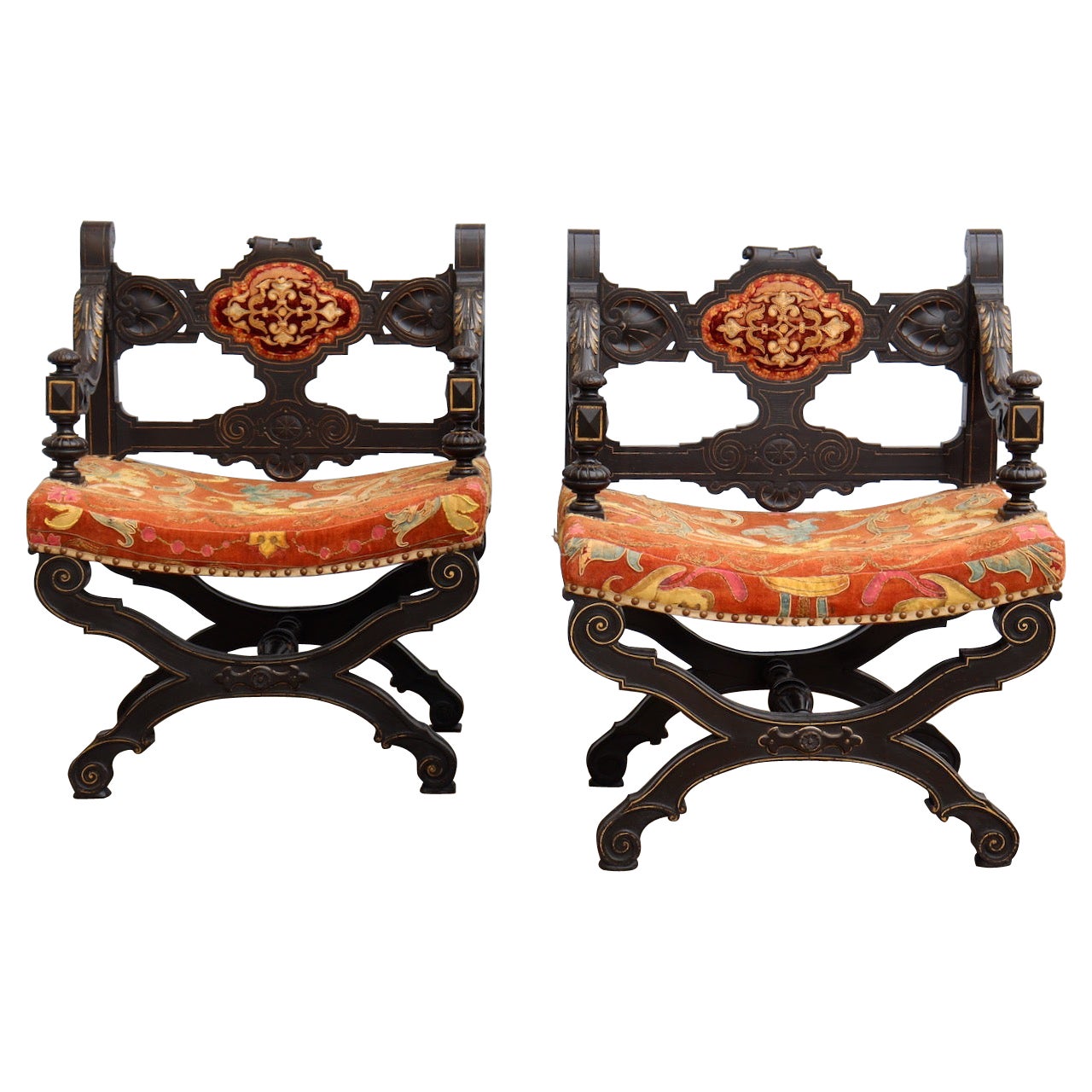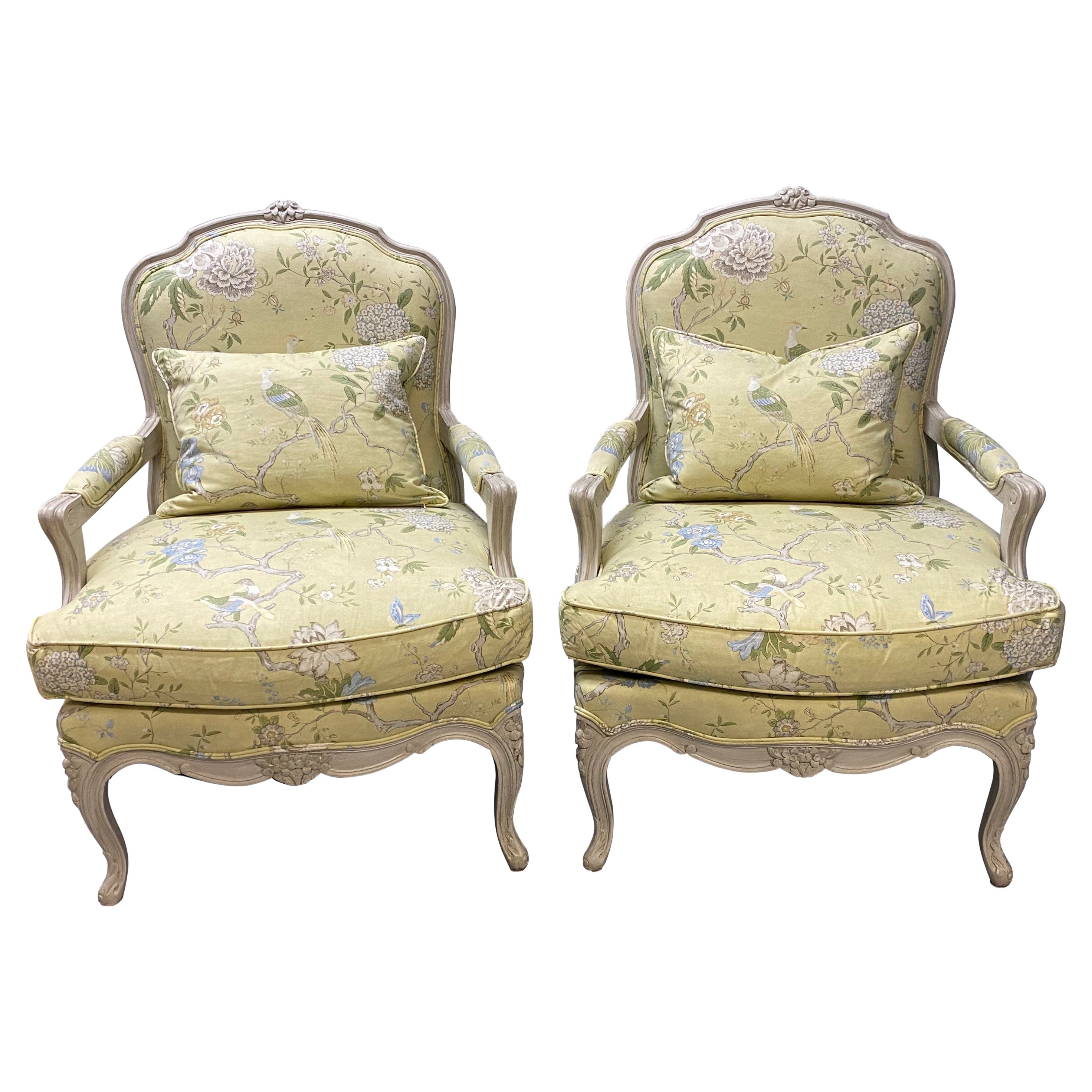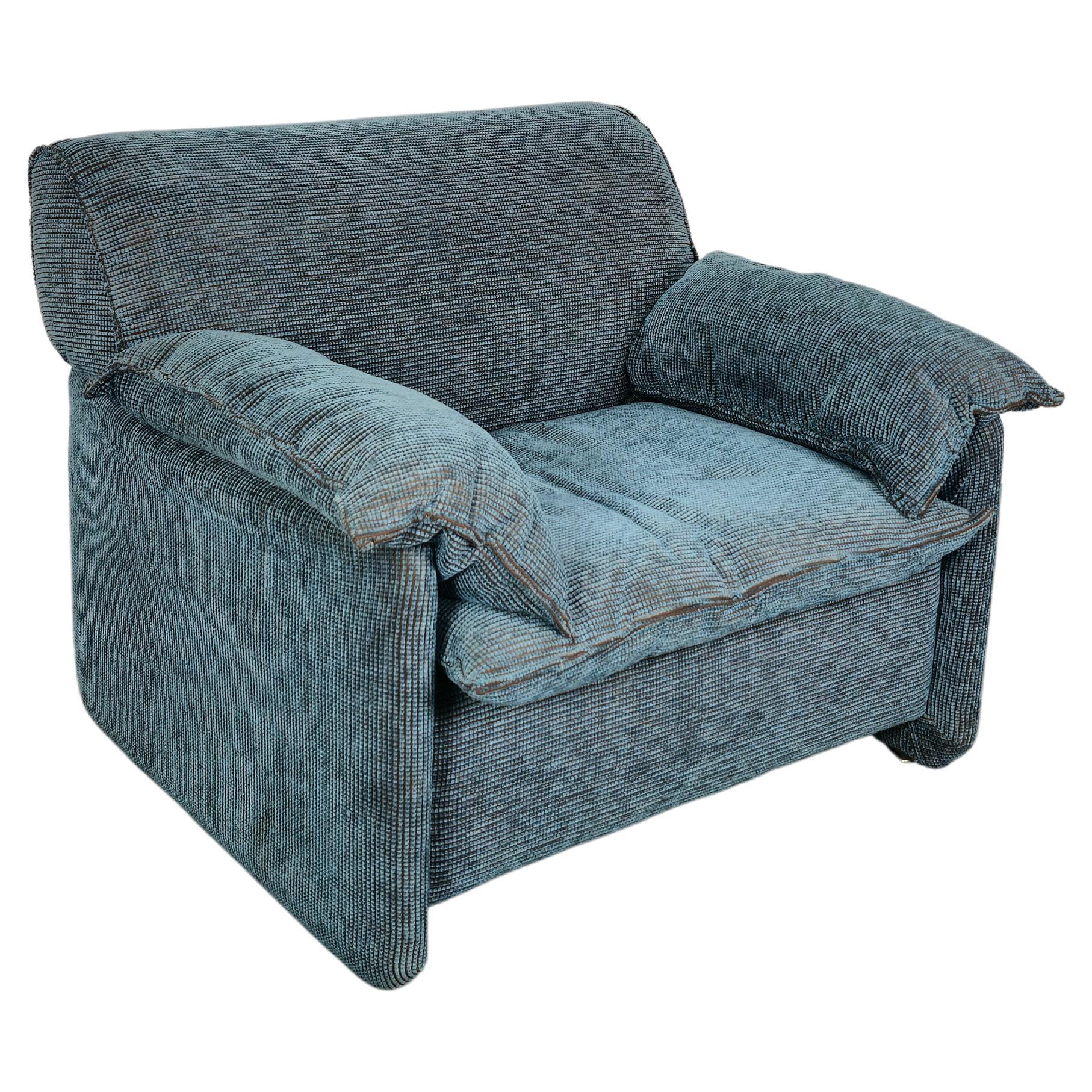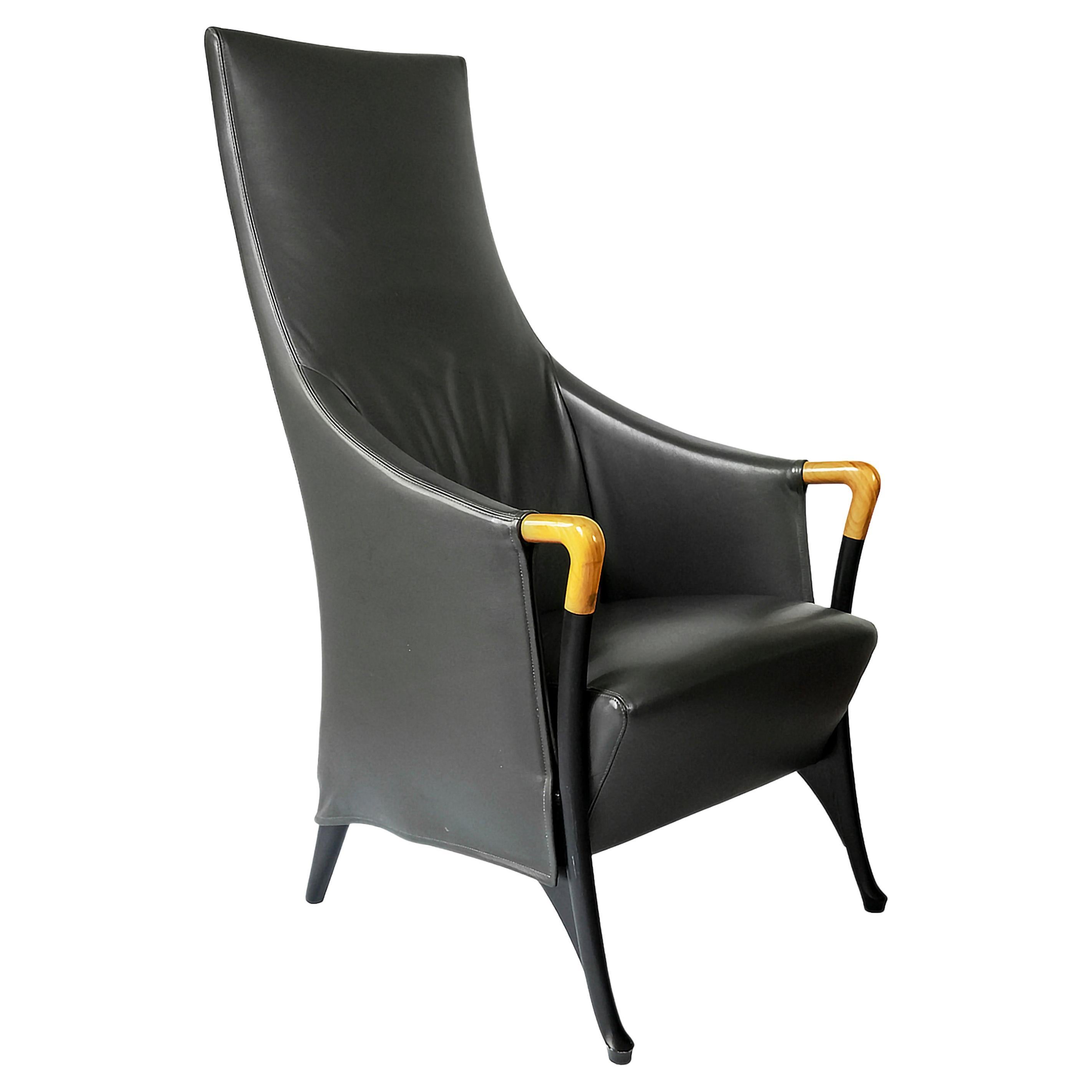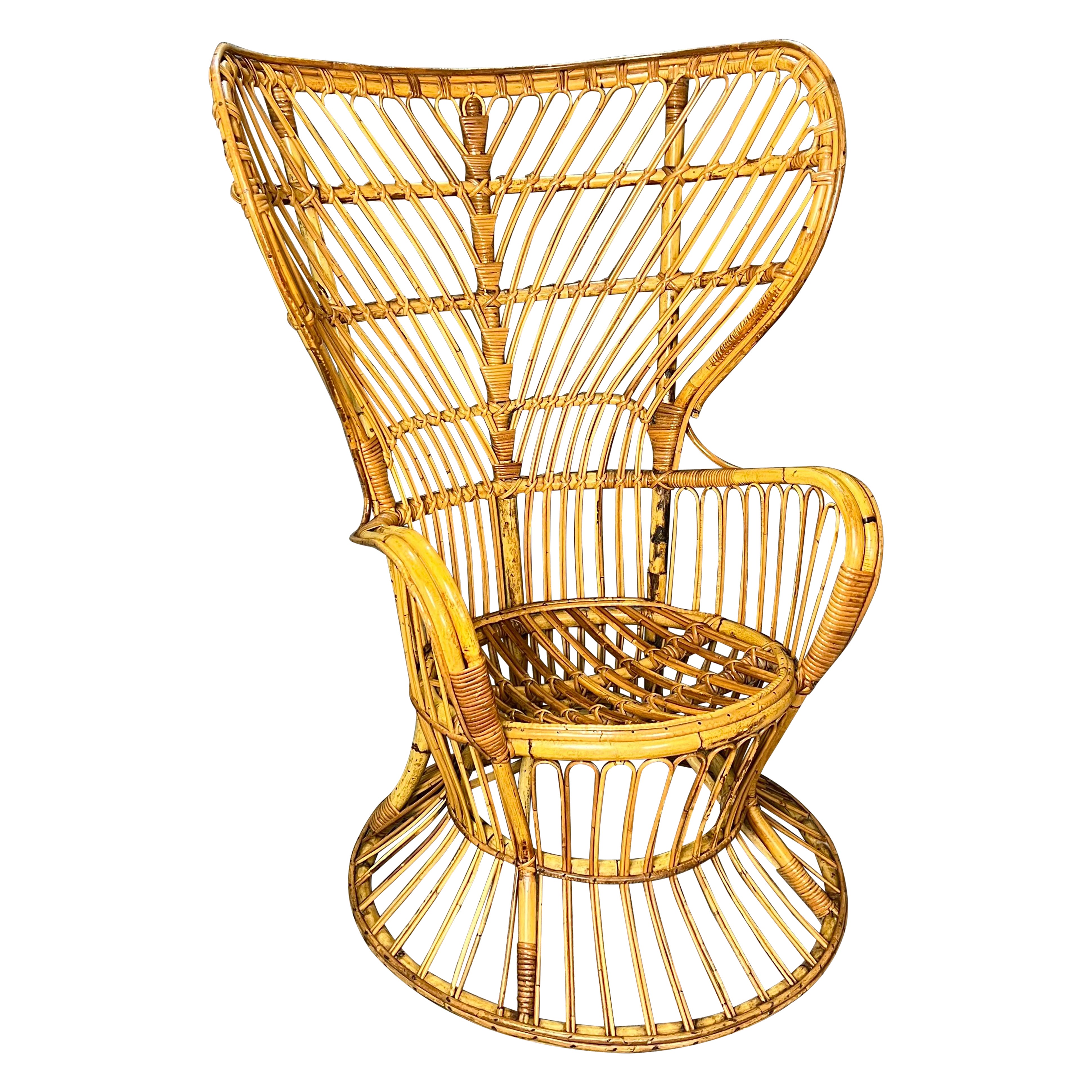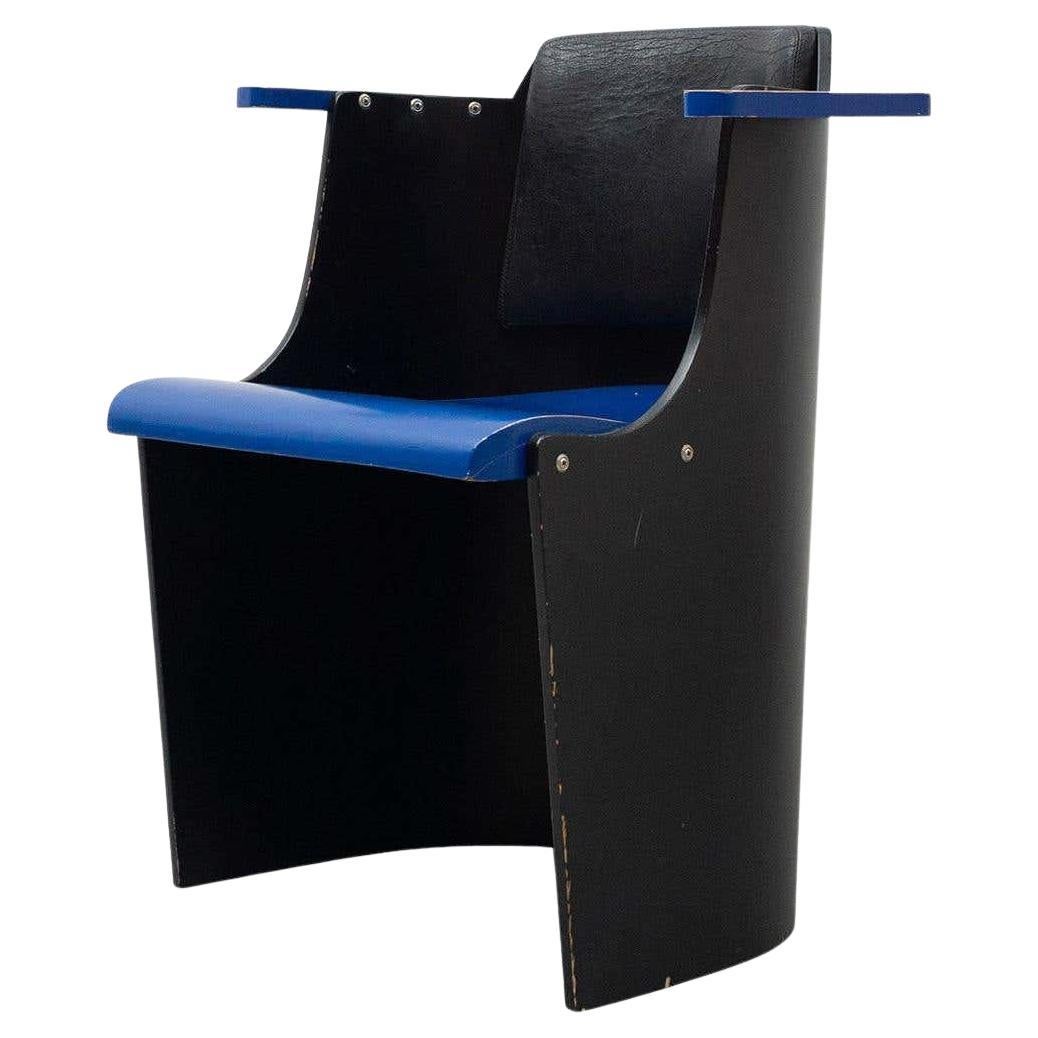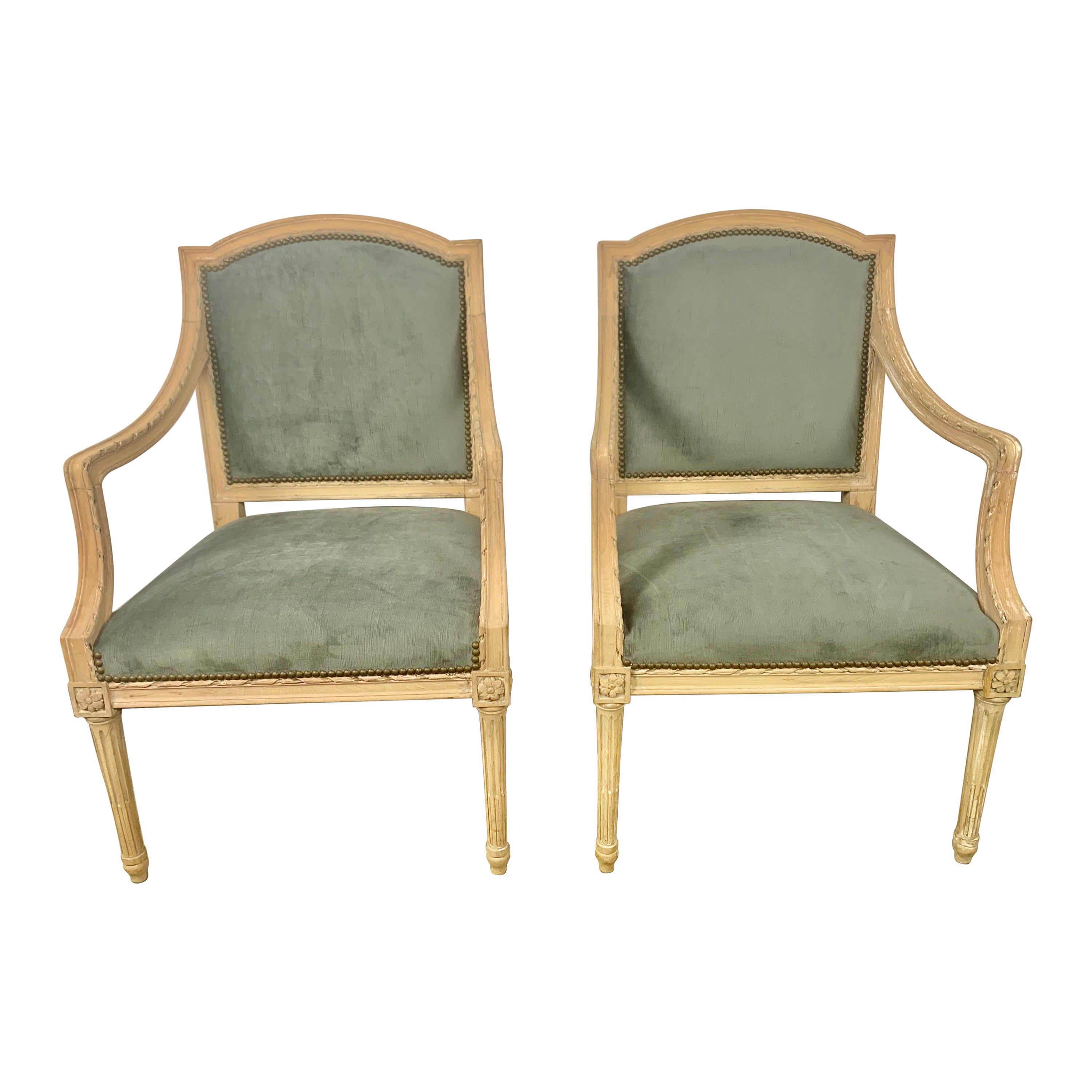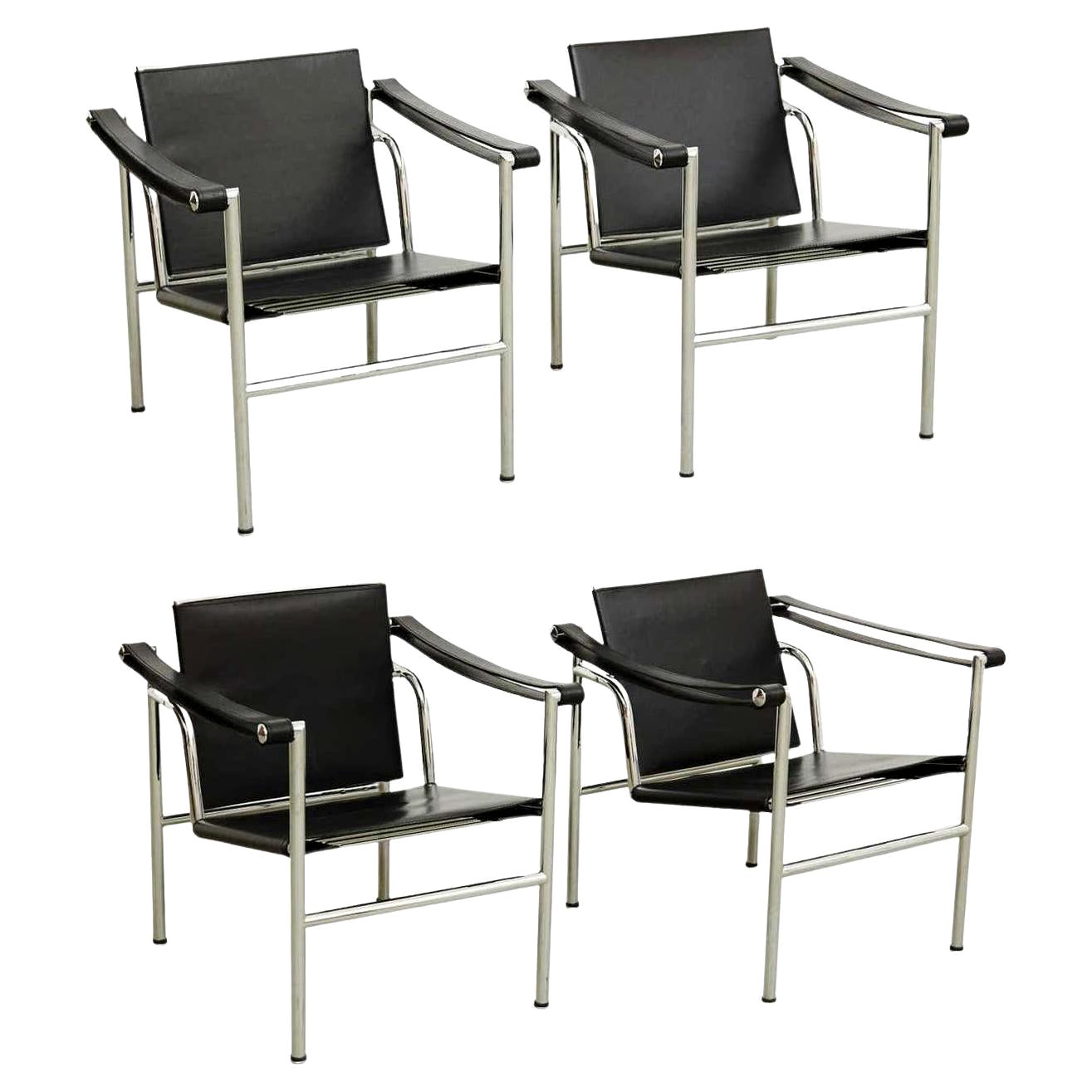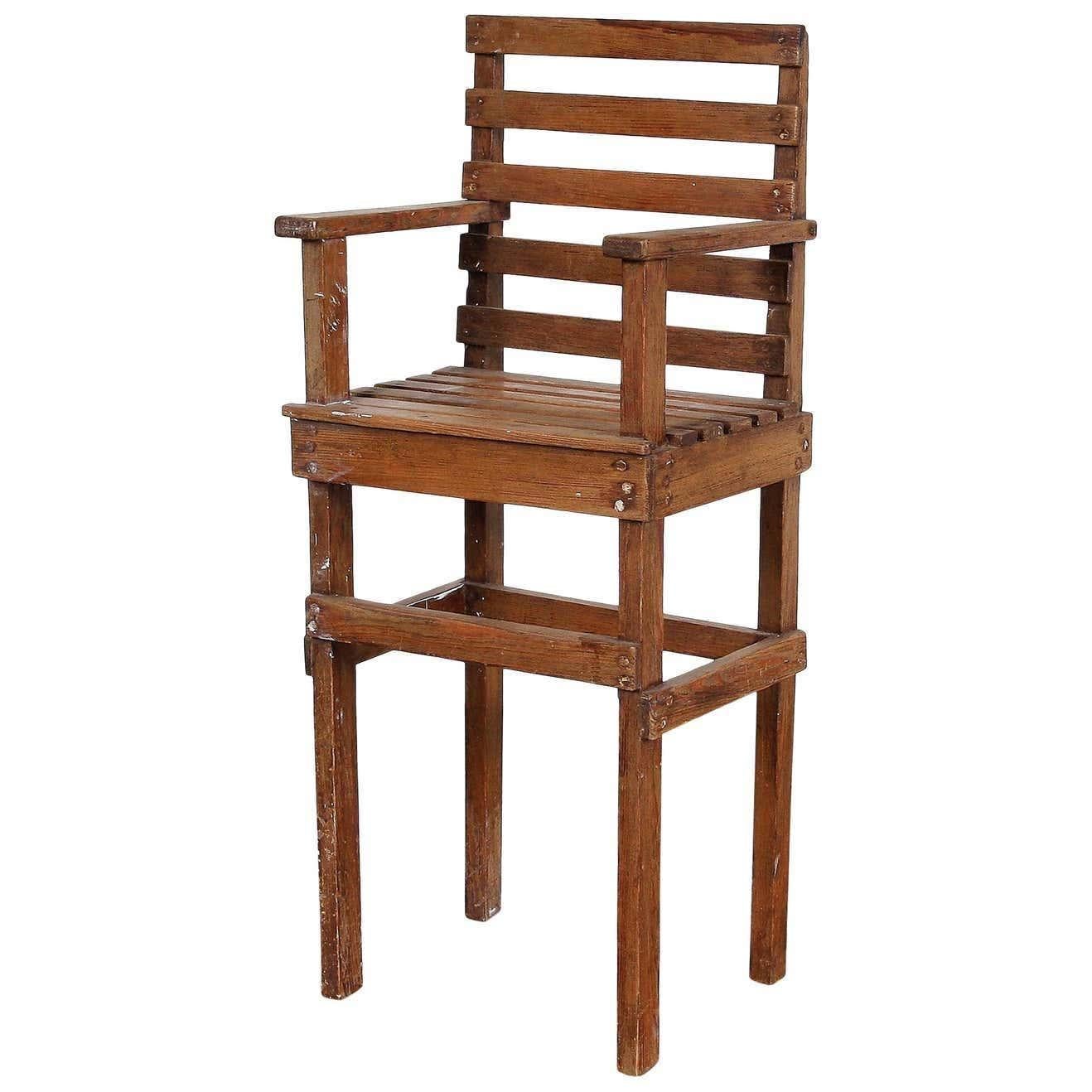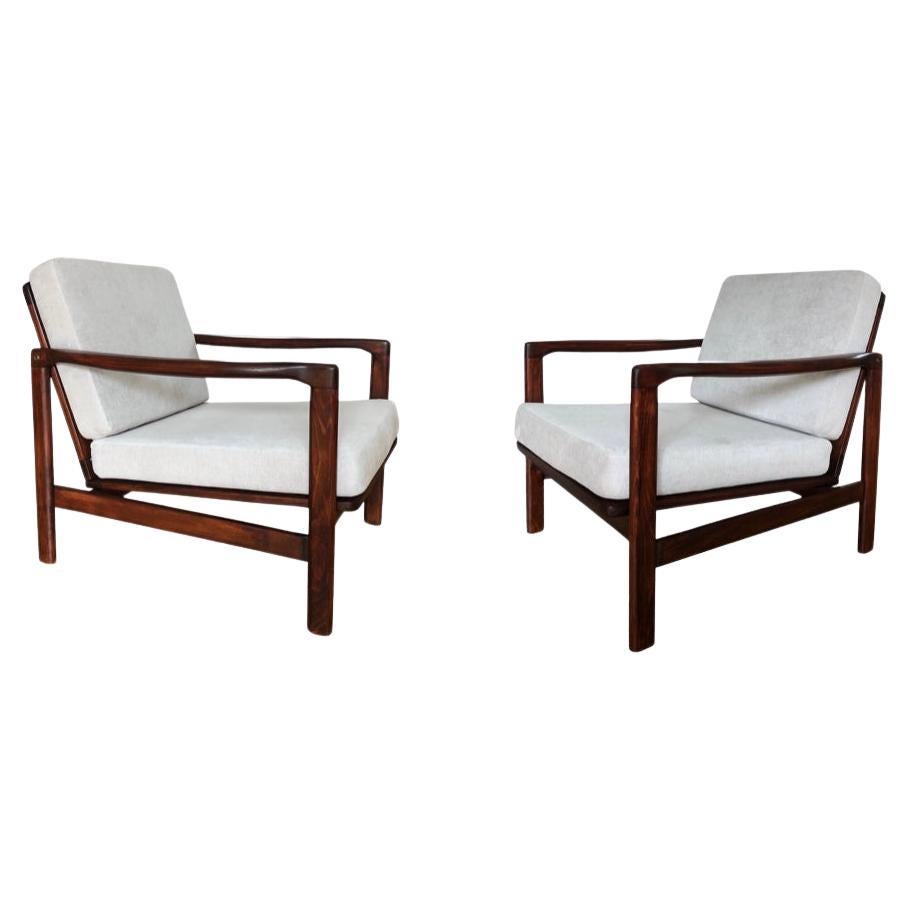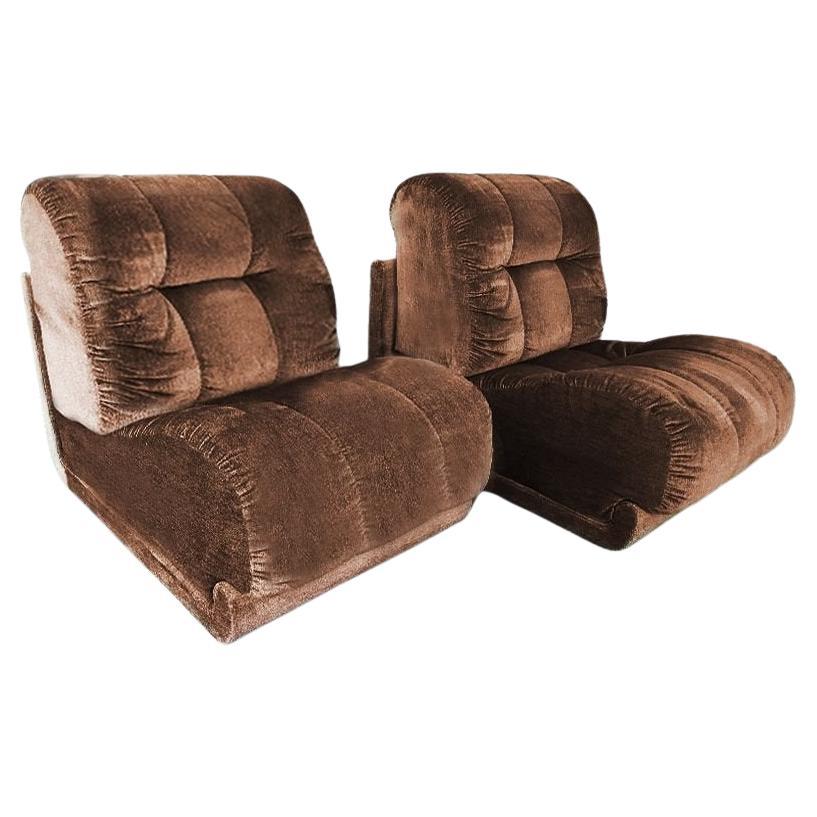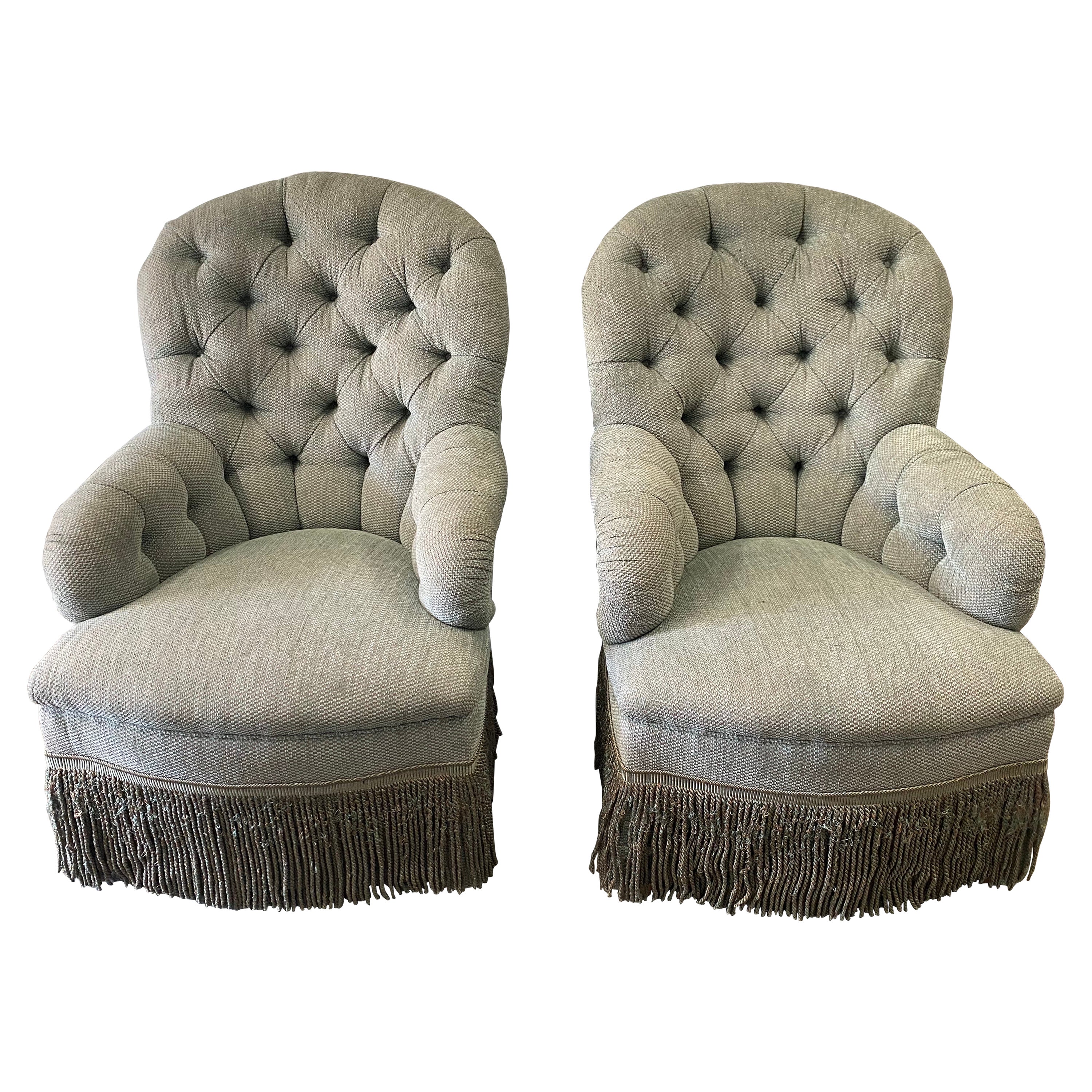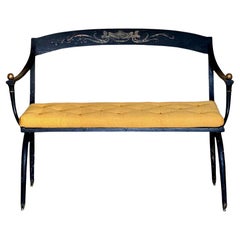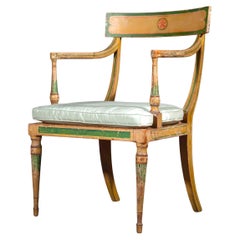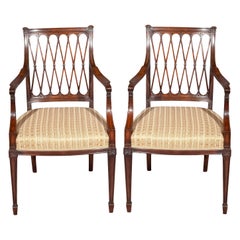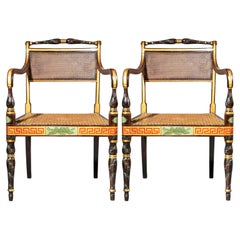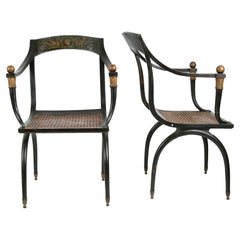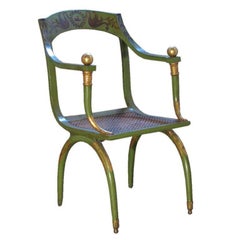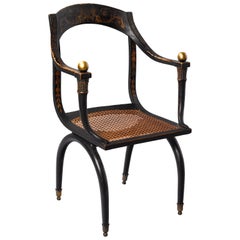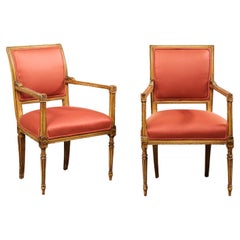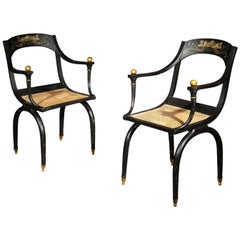
Pair of Antique Painted Curule Armchairs in the style of Jean-Joseph Chapuis
View Similar Items
Want more images or videos?
Request additional images or videos from the seller
1 of 13
Auction endedBrowse Current Auctions
Pair of Antique Painted Curule Armchairs in the style of Jean-Joseph Chapuis
Price:$14,286.28
$17,295.73List Price
About the Item
- Attributed to:Jean Joseph Chapuis (Designer)
- Dimensions:Height: 34.5 in (87.63 cm)Width: 21.5 in (54.61 cm)Depth: 23.5 in (59.69 cm)Seat Height: 18 in (45.72 cm)
- Sold As:Set of 2
- Style:Neoclassical (In the Style Of)
- Materials and Techniques:
- Place of Origin:
- Period:
- Date of Manufacture:circa 1890–1900
- Condition:Refinished. Wear consistent with age and use. Good antique condition, structurally sound and ready to be placed, painted decoration is distressed from time/use, some loss to the painted finish as evident from the photographs.
- Seller Location:Richmond, GB
- Reference Number:1stDibs: LU1781222714452
About the Seller
5.0
Gold Seller
Premium sellers maintaining a 4.3+ rating and 24-hour response times
Established in 2014
1stDibs seller since 2016
235 sales on 1stDibs
Typical response time: 4 hours
Associations
LAPADA - The Association of Arts & Antiques Dealers
Authenticity Guarantee
In the unlikely event there’s an issue with an item’s authenticity, contact us within 1 year for a full refund. DetailsMoney-Back Guarantee
If your item is not as described, is damaged in transit, or does not arrive, contact us within 7 days for a full refund. Details24-Hour Cancellation
You have a 24-hour grace period in which to reconsider your purchase, with no questions asked.Vetted Professional Sellers
Our world-class sellers must adhere to strict standards for service and quality, maintaining the integrity of our listings.Price-Match Guarantee
If you find that a seller listed the same item for a lower price elsewhere, we’ll match it.Trusted Global Delivery
Our best-in-class carrier network provides specialized shipping options worldwide, including custom delivery.More From This Seller
View AllRare 19th Century Painted Bench or Settee, ex-Madeleine Castaing, after Chapuis
By Jean Joseph Chapuis
Located in Richmond, London
A very rare 'curule' settee, late 19th century after a design by Jean-Joseph Chapuis.
Provenance: Madeleine Castaing, Maison de Lèves, Chartres, France.
Why we like it
Besides the iconic provenance, this bench is a great example of the 19th century design, informed by classical antiquity. Decorated in the exotic 'Etruscan' style to simulate patinated bronze, with its dramatically exaggerated curves, evoking the ancient Roman 'sella curulis' - a symbol of magisterial power, this settee is truly a special example of its kind. A squab cushion covered in a fabric complimenting other textiles in the existing interior will complete the look of this super-stylish bench.
Provenance – Madeleine Castaing
Together with a pair of armchairs en-suite (sold by us in may 2022), this settee was photographed in the vestibule at Maison de Lèves near Chartres - country house of the iconic French interior designer and antiques dealer Madeleine Castaing (1894–1992). Madeleine married the heir and art critic Marcellin Castaing – the legendary love of her life – who in the 1920's acquired a neoclassical gentilhommière at Lèves, that she had been admiring since her days in a convent school nearby, for her to "unwind" as he explained. The house would become one of her masterpieces as she discovered her own vocation for interior design. Extant photographs reveal a number of changes that had been made to the interiors over time. The writer Maurice Sachs once wrote about Madeleine's passion for her home: “The constant transformations she made to the estate kept her as busy as the world can keep a socialite…”. The contents of Maison de Lèves as well as Castaing's Rue Jacob...
Category
Antique Late 19th Century Belgian Neoclassical Revival Benches
Materials
Wood, Cane, Upholstery
Rare George III Painted Armchair
By Gillows of Lancaster & London
Located in Richmond, London
A rare and elegant cream and green painted armchair of George III period, attributable to Gillows of Lancaster and London. England, circa 1800. Highly desirable and sought after mode...
Category
Antique Late 18th Century European Armchairs
Materials
Upholstery, Paint
Pair of 19th Century Open Armchairs
By Gillows of Lancaster & London
Located in Richmond, London
A superb quality pair of open armchairs, after late 18th century designs by Gillows of Lancaster and London, the manufacture attributable to Gillow & Co. English, circa 1880.
Why we like them
Wonderfully elegant model, looking very delicate but in fact unusually strong – the sign of a skilled craftsman. Interestingly, chairs of this exact model can be seen in a painting by Walter Dendy Sadler (British, 1854-1923), The After Lunch Conversation, 1889, sold at Doyle, New York, 21 May 2024, lot 83.
Design
These chairs correspond to Gillows’ 'Garforth pattern' - a rare and highly desirable design - which first appeared in 1795 and was probably an adaptation of Georges Jacob's design of circa 1792 for Marie-Antoinette's dairy at Rambouillet. Gillows made the chairs not only in mahogany but also japanned, and they appear to have been particularly popular among the genteel, professional, and merchant classes in the north of England. In 1796, the Earl of Strafford purchased six white and green japanned chairs for Wentworth Woodhouse...
Category
Antique Late 19th Century European Armchairs
Materials
Upholstery
$5,493 / set
19th Century Regency Painted Armchairs
Located in Richmond, London
An elegant pair of painted open armchairs from the early 19th century English Regency era, exquisitely hand-painted to simulate exotic timber and decorated with neoclassical festive ...
Category
Antique Early 19th Century English Regency Armchairs
Materials
Wood, Cane, Paint
$9,823 / set
Early 19th Century Pair of Regency Black Painted Caned Chairs, 3 Pairs Available
By Thomas Sheraton
Located in Richmond, London
A superbly decorative pair of side chairs, exquisitely hand-painted to simulate exotic timber and ornamented with neoclassical festive ribbons and garlands, with Greek key border to ...
Category
Antique Early 19th Century English Regency Chairs
Materials
Wood
Rare 19th Century Painted Armchair Attributed to Gillows
By Gillows of Lancaster & London
Located in Richmond, London
An extremely rare and elegant cream and green painted armchair of George III period, attributable to the renown firm of Gillows of Lancaster and London. English, circa 1805–10. Truly...
Category
Antique Early 19th Century English Regency Armchairs
Materials
Upholstery, Paint
You May Also Like
Jean-Joseph Chapuis Rare Pair of Empire parcel-gilt japanned Fauteuils
By Jean Joseph Chapuis
Located in Worpswede / Bremen, DE
Despite his long life, very little is known about the general production of menuisier (chairmaker) Jean-Joseph Chapuis and even less about his use of bent laminates, which must be viewed as the most advanced of its kind until the appearance of Michael Thonet’s work of the 1830s.
The profound reverence for the classical world in enlightened circles in early nine-teenth-century Europe and the United States often resulted in the archaeological resurrection of the art, architecture, and design of ancient Greece and Rome. No chair employing the innovative technique of bending wood more boldly expresses this allegiance to the past than this armchair painted in le style antique and based on the ancient Roman sella curulis (folding stool); With a curved toprail decorated with putti supporting a medaillion and flanked by scrolling acanthus, the arms with ball finials, above a caned seat, on curved supports terminating in foliate gilt-metal sabots. This merger of technological innovation with fashionable aesthetics parallels the work of the American Samuel Gragg...
Category
Antique Early 19th Century Belgian Empire Armchairs
Materials
Bentwood
Painted 19th Century Armchair by Jean-Joseph Chapuis
Located in Troy, NY
Neoclassical green painted and gilt armchair with caned seat.
After a model by Jean-Joseph Chapuis.
The front legs retain their brass casters, the rear legs are missing the casters.
Category
Antique 19th Century French Neoclassical Armchairs
Materials
Cane, Wood
Important Empire Early 19th Century Fauteuil by Jean-Joseph Chapuis
By Jean Joseph Chapuis
Located in Worpswede / Bremen, DE
Despite his long life, very little is known about the general production of menuisier (chairmaker) Jean-Joseph Chapuis (1765-1864) and even less about his use of bent laminates, which must be viewed as the most advanced of its kind until the appearance of Michael Thonet’s work of the 1830s.
The profound reverence for the classical world in enlightened circles in early 19th century Europe and the United States often resulted in the archaeological resurrection of the art, architecture, and design of ancient Greece and Rome. No chair employing the innovative technique of bending wood more boldly expresses this allegiance to the past than this armchair painted in le style antique and based on the ancient Roman sella...
Category
Antique Early 19th Century Belgian Empire Armchairs
Materials
Cane, Bentwood
Antique Pair of Neoclassic Style Armchairs, Italy
Located in Atlanta, GA
An Italian pair of Neoclassical style armchairs from the early 20th century. This antique pair of accent chairs from Italy are each carved with n...
Category
Early 20th Century Italian Neoclassical Armchairs
Materials
Upholstery, Wood
A Pair of Vintage Armchairs, in Style of Jean Prouvé, Scandinavia 1960s
By Jean Prouvé
Located in Hønefoss, 30
A pair of armchair by unknown designer from 1960s, in style of Jean Prouvé. Arms and legs of dark stained wood with new linen cushions.
A simple and fuctional design made comfortab...
Category
Mid-20th Century Norwegian Mid-Century Modern Chairs
Materials
Linen, Wood
Pair of English Mahogany and Leather Armchairs in the Neoclassical Style
Located in London, GB
A fine pair of armchairs in the neoclassical in the manner of Robert Adam
Constructed in mahogany with hand-painted gilt accents and red leather, each with oval backs enclosed wit...
Category
Antique Late 19th Century Scottish Neoclassical Chairs
Materials
Leather, Mahogany, Giltwood
